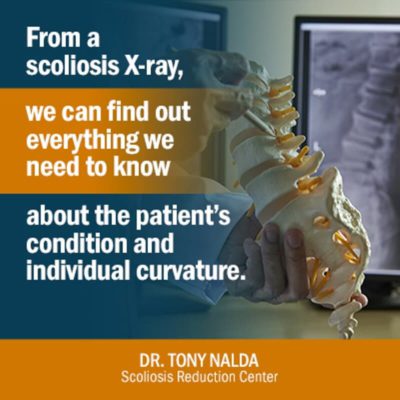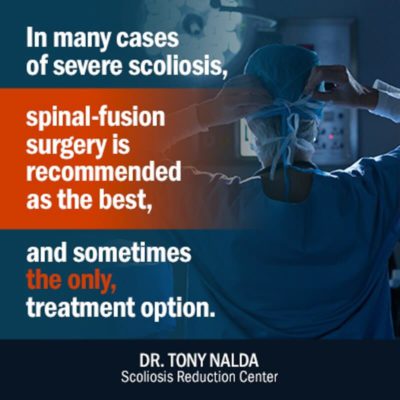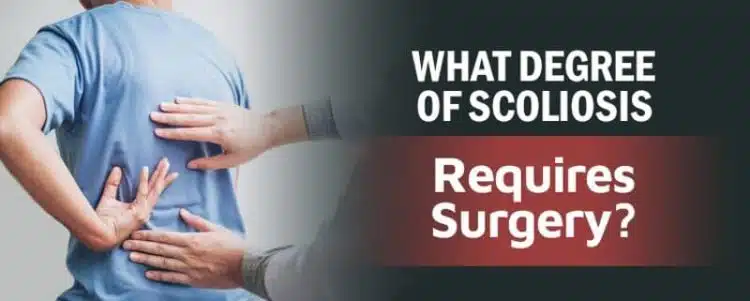Scoliosis takes many forms. Its degree of severity is determined via X-ray and a measurement known as the Cobb angle; this measurement uses the apex of the curve to class the curvature as mild, moderate, or severe. Whether or not surgery is recommended depends upon the condition’s severity, age of patient, treatment approach, and the surgical threshold of the country in which the surgery will take place.
How Scoliosis is Classified
Scoliosis is a complex condition with many fluctuating variables and symptoms differing from one patient to the next. As adolescent idiopathic scoliosis (AIS) is the condition’s most common form, we’ll focus on this age group.
In order for a patient to receive an official scoliosis diagnosis, a visual assessment will be done and an X-ray will be taken. From a visual assessment, specialists will be able to spot any – body asymmetries such as uneven shoulders, hips, or the characteristic rib hump that could indicate a need for further testing.
How scoliosis is classified is important because it determines how a condition should be treated and how the patient is likely to experience their condition.
Forward Bend Test
- A visual test such as the Forward Bend Test, also known as the Adam’s Test, will likely be performed.
- During this test, the patient is told to stand up straight, then bend forward, as if touching their toes, at a 90-degree angle.
- When the body is bent over, the spinal cord is more visible.
- When paired with a scoliometer, a Forward Bend Test is a reliable means of finding indicators of the condition and the need for a scoliosis X-ray.
X-Ray and the Cobb Angle

When it comes to diagnosing and classifying a patient’s scoliosis, an X-ray is the gold standard. X-rays are noninvasive, accessible, reliable, inexpensive, and quick.
From a scoliosis X-ray, we can find out everything we need to know about the patient’s condition and individual curvature.
It’s at this point that I highly recommend patients ensure they’re working with a scoliosis specialist.
While most doctors would be able to spot an abnormal spinal curvature, when it comes to being able to fully interpret a scoliosis X-ray, seeing a specialist is highly beneficial.
Reading a Scoliosis X-ray: A 2-Dimensional Image of a 3-Dimensional Condition
- There’s more to measuring scoliosis than just determining the Cobb angle. Being able to comprehensively read and interpret scoliosis X-ray results is a hugely important part of coming up with an effective treatment plan.
Here at the Scoliosis Reduction Center®, when patients come to me, I use several measurements to assess their condition. Taken from a variety of angles, I use X-rays to view what’s happening with the spine in terms of twist, tilt, and other important factors.
As scoliosis is a 3-D condition, relying solely on 2-D measurements of a curvature will fall short when it comes to customizing an effective treatment plan.
Scoliosis Reduction Center® X-Ray Technology
The Scoliosis Reduction Center® uses X-rays on a daily basis to diagnose, assess, and measure our patients’ scoliosis.
Through our use of the latest digital X-ray technology, we can promise accuracy and minimal exposure to radiation. We rely on small specifically-targeted X-ray machines to assess the spine’s biomechanical integrity and produce reliable and precise measurements
I’ve dedicated my life to the specific study of scoliosis, so I’ve performed thousands of scoliosis X-rays over the years. This experience has enabled me to develop strategies for reading scoliosis X-rays more comprehensively than the average health-care practitioner; by extension, this ability allows me to craft a more customized and effective treatment plan.
What’s a Cobb Angle?
- First described by Dr. John R. Cobb in 1948, Cobb angle is a measurement of the degree to which a spine deviates from a straight alignment.
- A patient’s Cobb angle is measured by first locating the most tilted vertebra at the apex of the curve. From there, a parallel line is drawn to the superior vertebral end plate. Next, the most tilted vertebra is located at the base of the curve and another parallel line is drawn to the inferior vertebral end plate. Then intersecting perpendicular lines are erected from the two parallel lines from the curve’s apex and bottom.
- The Cobb angle refers to the angle formed between those two parallel lines.
Determining the Cobb angle is important because it allows us to classify a patient’s condition on the severity scale:
- Mild scoliosis: Cobb angle measurement of 25 degrees or less
- Moderate scoliosis: Cobb angle measurement between 25 and 40 degrees
- Severe scoliosis: Cobb angle measurement of 40-plus degrees for adolescents and 50-plus for adults.
Once a patient receives an official diagnosis and has a Cobb angle measurement via X-ray, other variables such as age, location of the curvature, and cause further classify the condition.
Further Classifying a Condition
Conditions are classified for a number of reasons.
- Common classifications include a patient’s age, condition type, and condition severity; this helps health-care professionals gauge what they’re dealing with.
- Classifying a patient’s scoliosis is as much for the patient’s benefit as it is for the health-care professionals. Understanding a condition from a number of important touch-points increases the likelihood of the patient’s condition being treated successfully.
- Knowing the condition severity, age, curvature location, and cause of a patient’s condition helps determine the best possible course of treatment. These variables are also beneficial in preparing the patient for what to expect in terms of the scoliosis-related symptoms they are most likely to experience.
Age of Patient and Pain
Age is generally the first stage of condition classification as it helps paint an overall picture of the patient. Age is particularly important to scoliosis because there is a marked difference between how adolescents and adults experience scoliosis-related pain.
Due to the spine’s lengthening motion during the growth that characterizes the adolescent stage, many young people don’t experience pain as part of their condition.
With an adult, however, it is very likely that pain will be a symptom. As growth and lengthening is no longer a factor, the curvature can cause compression of the spine, resulting in various levels of pain and discomfort. While it often expresses itself in areas other than the back such as the hips, knees, and feet, for adult patients, scoliosis-related pain is commonly expressed.
In this instance, the patient’s age is one of the main factors that determine how painful the condition is likely to be, and age is also an important factor when it comes to deciding whether surgery is an option or not. When it comes to spinal-fusion, after the age of 40, the question changes from “will there be complications” to “how bad will the complications be.”
Age of Patient and Progression
While there is no known cure for scoliosis, there are known treatment options. When it comes to treating scoliosis, the goal is to manage and control its progression.
The more a patient’s condition has progressed by the time they come to see me, the more work needs to be done to achieve a curvature reduction.
- With adolescents, progression is monitored closely as growth is the number one cause of progression and the adolescent stage is characterized by rapid growth spurts.
- While growth is no longer a factor for adults, progression is still a concern. The larger a curvature is, the more likely it is that it will progress. Adults over the age of 50 are also more likely to experience the type of disc degeneration that can cause a spinal curvature to develop.
While no one can look at a patient’s scoliosis and know exactly how their condition is going to progress, age can help us predict how likely it is that a patient will experience progression and how rapid that progression is likely to be.
Curvature Location
Knowing where a patient’s curvature is located along the spine, and in which direction it bends, is an important classification step as different curvature locations carry different symptoms and treatment needs.
- Thoracic scoliosis: curvature in the spine’s middle portion (most common)
- Lumbar scoliosis: curvature in the spine’s lower portion
- Thoracolumbar scoliosis: curvature that includes both lower thoracic and upper-lumbar vertebrae
- Dextroscoliosis: sideways curvature that bends to the right
- Levoscoliosis: sideways curvature that bends to the left
Condition Cause
The lion’s share of scoliosis cases are classed as ‘idiopathic’, meaning no known single cause, and this accounts for 80 percent of known diagnosed cases. The remaining 20 percent with known causes are classed as congenital, neuromuscular, degenerative, or traumatic.
- Congenital scoliosis: develops as a result of malformed bone the patient was born with
- Neuromuscular scoliosis: develops as a secondary complication of diseases such as cerebral palsy or muscular dystrophy
- Degenerative scoliosis: develops in older people whose spinal discs have degenerated with age
- Traumatic scoliosis: develops as a result of an adverse trauma to the spine
Once a doctor or surgeon has a patient’s condition fully classified by age, condition severity, location of the curve, and cause, an appropriate treatment path can be decided upon; that treatment path can fork in two different directions with very different outcomes: traditional vs. functional.
Traditional Treatment Approach
The traditional treatment path is frequently traveled, and it is the path most likely to involve passive observation and end with a recommendation for spinal-fusion surgery.
While the traditional approach can involve some scoliosis-specific exercises and bracing, the most common recommendation is to watch and wait to see at what rate, if any, a condition progresses.
As I mentioned earlier, the condition’s most common form is AIS, meaning adolescents between the age of 10 and 18 make up the largest age group diagnosed with the condition; this is an age group characterized by rapid and unpredictable growth spurts.
While there are many aspects of scoliosis that remain a mystery, one thing we do know if that growth speeds up progression. While we can’t manage or control our patients’ growth, we can certainly monitor it and counteract the resulting progression.
The issue I have with the watch-and-wait approach is that in-between doctor’s visits or scheduled X-rays, an adolescent can experience a significant growth spurt that can cause the condition to progress significantly. In my opinion, the time spent watching and waiting would better serve the patient by initiating and establishing a proactive and effective treatment plan early on.
What often happens in the traditional approach is that a patient is observed until their condition progresses to a certain severity level and surgery is then recommended as the best option, but that surgery can come at a high price, and not just in monetary terms.
Functional Treatment Approach
My approach is a functional one, meaning the goal is to improve and facilitate the spine’s function, rather than holding it in a straighter alignment at the cost of mobility. Through scoliosis-specific chiropractic care and exercises, custom 3-D bracing, and therapy, my team and I offer our patients the benefits of a variety of treatment approaches.
Once we assess those initial X-rays, we take into account how much the adolescent patient has grown, how much their spine has grown, and how much they are likely still to grow. From there, we design a customized proactive treatment plan that works to reduce the curvature and stabilize the scoliosis.
Once we achieve a reduction, we know what works and we augment that work with at-home exercises and stretches for the patient. If there is an inch of growth, I monitor how that growth affects progression and adjust the treatment plan accordingly.
Here at the Scoliosis Reduction Center®, we don’t watch and wait: we act. While the traditional approach might suggest that there’s no harm in watching and waiting, I firmly believe the opposite is true.
If a condition is left to progress unimpeded, the curvature is only that much harder to reduce down the road; however, there is certainly no harm in acting early and staying ahead of the curve.
Spinal-Fusion Surgery: What You Should Know

In many cases of severe scoliosis, spinal-fusion surgery is recommended as the best, and sometimes the only, treatment option. While surgeons have their patients’ best interests at heart, even the most minor of surgeries carry risks, and spinal-fusion is no minor surgery.
Spinal-fusion surgery is an invasive and lengthy surgery that, I believe, should only be considered as a last option when every other form of treatment has been unsuccessful.
While there are several variations of the surgery, most use hardware such as hooks, bolts, and screws that are attached to the spine so long rods can be anchored on each side of the spine to hold it in a corrective position.
Bone grafts are then applied to the vertebral segments that are going to be fused. Bone grafts are most often taken from a donor, the patient, or a bone bank (allograft). The rods act as a splint to hold the spine in position as the bones fuse; the initial fusion can take between 3 and 6 months, with full fusion taking up to 12 months after surgery.
Living With a Fused Spine
What I want people to know, and what I devoted large sections of my book Scoliosis Hope to explain, is that while spinal-fusion surgery can make a crooked spine straighter, it does not cure the condition; nothing and no one can do that, nor can the surgery guarantee to halt progression. What the surgery does is treat the main symptom of the condition – the abnormal curvature – but it doesn’t treat the underlying condition itself; that’s what we do here at the Scoliosis Reduction Center®.
Patients who come to me post-surgery are often seeking help managing their pain and looking to improve their mobility and flexibility. Spinal-fusion holds the spine in position, but being held in a corrective position is a lot different than actually achieving a reduction through natural means, such as chiropractic adjustments, and the spine maintaining that position naturally and functionally.
Living with a fused spine can have a heavy emotional weight. Many people report an anxiousness they didn’t have before regarding how fragile their spine actually is. As its ability to absorb shock is compromised, certain activities are no longer safe, and many people struggle with trying new things or just enjoying day-to-day life without worrying about what their spine can and can’t handle.
Surgical Threshold is Variant by Country
Just as laws vary from state to state and country to country, healthcare-industry protocols and guidelines also vary. In the United States, severe scoliosis is defined as a curvature with a Cobb angle measurement of 40-plus degrees in adolescents and 50-plus in adults.
The States has the lowest surgical threshold with surgeons most often recommending spinal-fusion surgery for severe cases with curvatures of 40-plus degrees or where progression is rapid.
In Canada, that threshold is higher at approximately 55 degrees and Europe is at the highest with approximately 60 degrees. Of course, this is not exact as the condition develops across a wide spectrum with treatment decisions that work for one case not working for another, not to mention other important variables such as age.
Conclusion
As an incurable progressive condition, the nature of scoliosis is to worsen. While no one can tell just how much a patient’s scoliosis will progress, visual assessments and X-rays can give us the information we need to make our predictions as accurate as possible. There is no curing scoliosis, but there are different approaches to managing and controlling its progression.
The traditional approach supports the practice of watching and waiting to see if a patient’s condition progresses in severity to the point where spinal-fusion surgery is deemed necessary. Obviously, I can’t say that there aren’t situations where spinal-fusion surgery is a favorable option, but I can say that it should be a last resort- after all other forms of treatment have been attempted.
Regarding the question of what scoliosis degree requires surgery, that answer will differ greatly based on the treatment approach that has been chosen. Based on my functional approach, I would say there’s very rarely a case where surgery is the best option.
Based on the traditional approach, a surgeon in the States often suggests surgery when progression is rapid or a patient’s Cobb angle measurement is 40-plus degrees. Spinal-fusion surgery can straighten a crooked spine, but it doesn’t cure the condition, nor does it guarantee the patient’s condition won’t continue progressing or that subsequent surgeries won’t be necessary.
Once a spine has been fused, it is less able to absorb force, limiting certain activities that are safe post-surgery. A spine that is held in place by rods and screws is also less flexible. These outcomes are why I dedicated my life to finding an effective alternative scoliosis treatment path.
If you or a loved one are facing the possibility of spinal-fusion surgery to treat scoliosis, I urge you to first explore other options such as my scoliosis-specific chiropractic approach. Through hard work and ingenuity, the Scoliosis Reduction Center® has helped transform the lives of thousands of people living their best lives with the condition.





